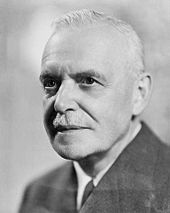- Kanadische Unterhauswahlen 1953
-
Die 22. kanadischen Unterhauswahlen (engl. 22nd Canadian General Election, frz. 22e élection fédérale canadienne) fanden am 10. August 1953 statt. Gewählt wurden 265 Abgeordnete des kanadischen Unterhauses (engl. House of Commons, frz. Chambre des Communes).
Inhaltsverzeichnis
Die Wahl
Premierminister Louis Saint-Laurent führte die Liberale Partei zum zweiten Mal zum Wahlsieg, obwohl sie einen etwas geringerem Wähleranteil erzielte und 22 Sitze an andere Parteien verlor. Zum fünften Mal in Folge konnten die Liberalen die Regierung bilden. Der Progressiv-konservative Partei mit George Alexander Drew, dem ehemaligen Premierminister Ontarios, an der Spitze gelang es wie schon 1949 nicht, sich bedeutend zu verbessern und blieb weiterhin in der Opposition.
Erstmals wahlberechtigt waren die Inuit.[1] Die Wahlbeteiligung betrug 67,5 %.
Ergebnisse
Gesamtergebnis
Partei Vorsitzender Kandi-
datenSitze
1949Sitze
1953+/- Stimmen Anteil +/- Liberale Partei Louis Saint-Laurent 262 191 169 - 22 2.731.633 48,43 % - 0,72 % Progressiv-konservative Partei George Alexander Drew 248 41 51 + 10 1.749.579 31,02 % + 1,37 % Co-operative Commonwealth Federation Major James Coldwell 170 13 23 + 10 636.310 11,28 % - 2,14 % Social Credit Party Solon Earl Low 71 10 15 + 5 304.553 5,40 % + 3,09 % Unabhängige 14 4 3 - 1 58.458 1,04 % - 1,01 % Unabhängige Liberale 19 1 2 + 1 68.506 1,21 % + 0,69 % Liberal-Labour [2] 1 1 1 11.380 0,20 % Liberal-Progressive 1 1 1 8.958 0,16 % Labour-Progressive Party Tim Buck 100 59.622 1,06 % + 0,50 % Nationalisten Adrien Arcand 1 7.496 0,13 % - 0,01 % Unabhängige Progressiv-Konservative 3 1.636 0,03 % - 0,11 % Christian Liberal 1 1.505 0,03 % + 0,03 % Independent Social Credit 1 422 0,01 % - 0,07 % Locataire (candidat) 1 417 0,01 % + 0,07 % Anti-Kommunisten 1 333 0,01 % + 0,01 % Sozialistische Arbeiterpartei 1 130 0,01 % + 0,01 % Total 897 262 265 + 3 5.640.938 100,0 % Ergebnis nach Provinzen und Territorien
Partei BC AB SK MB ON QC NB NS PE NL NW YK Total Liberale Partei Sitze: 8 4 5 7 50 66 7 10 3 7 1 1 169 Anteil in %: 30,9 35,1 37,3 37,0 46,0 61,0 52,7 53,0 51,1 67,2 49,4 78,7 48,4 Progressiv-konservative Partei Sitze: 3 2 1 3 33 4 3 1 1 51 Anteil in %: 14,1 14,5 11,7 27,0 40,3 29,4 41,9 40,1 48,0 28,1 38,5 21,3 31,0 Co-operative Commonwealth Federation Sitze: 7 11 3 1 1 23 Anteil in %: 26,6 6,9 44,2 23,6 11,1 1,5 3,0 6,7 0,8 0,6 11,3 Social Credit Party Sitze: 4 11 15 Anteil in %: 26,1 40,7 5,3 6,3 0,3 0,3 5,4 Unabhängige Sitze: 3 3 Anteil in %: 0,1 0,2 0,3 3,0 4,0 12,4 1,0 Unabhängige Liberale Sitze: 2 2 Anteil in %: 4,0 0,3 3,7 1,9 1,2 Liberal-Labour Sitze: 1 1 Anteil in %: 1,1 0,6 0,2 Liberal-Progressive Sitze: 1 1 Anteil in %: 3,3 0,2 Labour-Progressive Party Anteil in %: 2,2 2,7 1,1 2,3 1,0 0,7 0,2 1,1 Nationalisten Anteil in %: 0,5 0,1 Unabhängige Progressiv-Konservative Anteil: 0,1 < 0,1 Christian Liberal Anteil in %: 0,3 < 0,1 Independent Social Credit Anteil in %: 0,1 < 0,1 Locataire (candidat) Anteil in %: 0,1 < 0,1 Anti-Kommunisten Anteil in %: < 0,1 < 0,1 Sozialistische Arbeiterpartei Anteil in %: < 0,1 < 0,1 Sitze total 22 17 17 14 85 75 10 12 4 7 1 1 265 Einzelnachweise
- ↑ The evolution of the federal franchise
- ↑ Der Liberal-Labour-Abgeordnete schloss sich der liberalen Fraktion an.
Weblinks
- Elections Canada (Wahlbehörde)
Siehe auch
1867 | 1872 | 1874 | 1878 | 1882 | 1887 | 1891 | 1896 | 1900 | 1904 | 1908 | 1911 | 1917 | 1921 | 1925 | 1926 | 1930 | 1935 | 1940 | 1945 | 1949 | 1953 | 1957 | 1958 | 1962 | 1963 | 1965 | 1968 | 1972 | 1974 | 1979 | 1980 | 1984 | 1988 | 1993 | 1997 | 2000 | 2004 | 2006 | 2008 | 2011
Wikimedia Foundation.
Schlagen Sie auch in anderen Wörterbüchern nach:
Kanadische Unterhauswahlen 2011 — Die 41. kanadischen Unterhauswahlen (englisch 41st Canadian General Election, französisch 41e élection fédérale canadienne) fanden am 2. Mai 2011 statt. Gewählt werden 308 Mitglieder des kanadischen Unterhauses (engl. House of Commons,… … Deutsch Wikipedia
Kanadische Unterhauswahlen 1917 — Robert Borden … Deutsch Wikipedia
Kanadische Unterhauswahlen 1921 — William L. M. King … Deutsch Wikipedia
Kanadische Unterhauswahlen 1957 — John Diefenbaker … Deutsch Wikipedia
Kanadische Unterhauswahlen 1867 — John Macdonald … Deutsch Wikipedia
Kanadische Unterhauswahlen 1872 — John Macdonald … Deutsch Wikipedia
Kanadische Unterhauswahlen 1911 — Robert Borden … Deutsch Wikipedia
Kanadische Unterhauswahlen 1926 — William L. M. King … Deutsch Wikipedia
Kanadische Unterhauswahlen 1962 — John Diefenbaker … Deutsch Wikipedia
Kanadische Unterhauswahlen 2008 — Premierminister Stephen Harper … Deutsch Wikipedia


